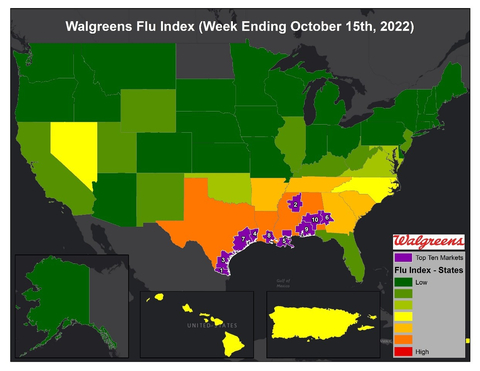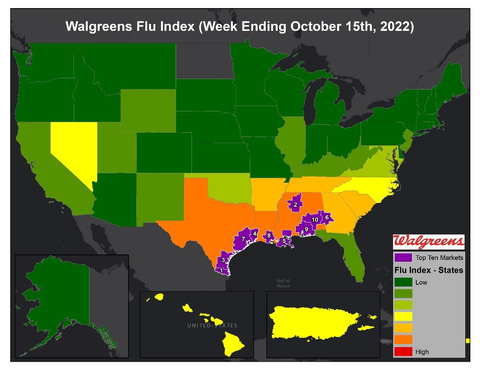DEERFIELD, Ill.--(BUSINESS WIRE)--Today Walgreens launched the 2022-2023 Walgreens Flu Index to help communities track flu activity in their area and serve as an important reminder to get protected with an annual flu shot. Returning for its ninth season, the Walgreens Flu Index shows that to date, overall flu activity is more than 10 times higher nationwide when compared to the 2021-2022 flu season and has more than doubled over the past two weeks.
“As we head into the fall and winter seasons, our data show significantly higher flu activity early this year when compared to other flu seasons and it’s increasing across the United States, especially in southern cities,” said Anita Patel, PharmD, vice president, pharmacy services development, Walgreens. “As we return to pre-pandemic activities and spend more time indoors without a mask or social distancing, we are more vulnerable to respiratory infections. To help reduce the spread of respiratory illnesses this season, the best thing you can do is schedule your annual flu shot and updated COVID-19 booster at Walgreens in one convenient stop.”
During the week of Oct. 10, flu activity was the highest in Louisiana, Texas and Mississippi. Several major cities, including New Orleans, Houston and Mobile, Ala. were designated the top ten areas with the most widespread flu activity so far this flu season.
A national survey showed many are either unsure or do not plan to get vaccinated against flu during this flu season.1 With rising rates of flu, COVID-19 older and new variants in circulation and other respiratory illnesses, hospitalizations are expected to rise and could result in a strain on the healthcare system.2 To prevent flu and its potentially serious complications, the Centers for Disease Control and Prevention (CDC) recommends everyone 6 months and older should get a flu vaccine by the end of October and before flu begins spreading during the holidays.3 If individuals are unable to get vaccinated until later, the CDC recommends still getting the flu shot because flu activity most commonly peaks in February and can continue through May. It takes about two weeks after the vaccine for antibodies to develop in the body and provide protection against the flu.
Walgreens makes it easy for the entire family to stay protected from the flu, with pharmacy team members who are specially trained to administer flu immunizations to adults and children ages 3 and up. Appointments are highly encouraged for the best experience. To schedule an appointment for a flu shot, the updated COVID-19 booster or other routine immunizations at Walgreens, please visit Walgreens.com/ScheduleVaccine or download the Walgreens app.
Top 10 DMAs with Highest Flu Activity
1. Harlingen-Weslaco-Brownsville-McAllen, Texas
2. Columbus-Tupelo-West Point-Houston, Miss.
3. Corpus Christi, Texas
4. Beaumont-Port Arthur, Texas
5. New Orleans, La.
6. Columbus, Ga. (Opelika, Ala.)
7. Houston, Texas
8. Lafayette, La.
9. Mobile, Ala.-Pensacola (Ft. Walton Beach), Fla.
10. Montgomery-Selma, Ala.
Top 10 States with Highest Flu Activity
1. Louisiana
2. Mississippi
3. Texas
4. Alabama
5. Georgia
6. Tennessee
7. Arkansas
8. South Carolina
9. Puerto Rico
10. North Carolina
About Walgreens Flu Index®
The Walgreens Flu Index® is an online, interactive tool that ranks the top markets and states for flu activity in the United States, including Puerto Rico, as well as the top markets and states showing the largest increases in flu activity week-over-week. Users can search by market or state to see where their geographic area ranks for flu activity in any given week, as well as how current flu activity compares to last season. Through the time lapse feature of the Walgreens Flu Index®, users can see how current flu activity compares to activity from last season. On a weekly basis, Walgreens tracks the incremental change of antiviral medications used to treat influenza across thousands of Walgreens and Duane Reade locations nationwide to create the Walgreens Flu Index®. The index is not intended to illustrate flu severity, but rather, based on this methodology, to show which populations are experiencing the highest incidence of influenza within the United States and Puerto Rico each week.
Flu Index® Frequency
The Walgreens Flu Index® is updated weekly each Tuesday and is available through an online, interactive map, linked here.
Behind the Methodology
Data for the Walgreens Flu Index ® is analyzed at state and geographic market levels to measure absolute impact and incremental change of antiviral medications on a per store average basis, and does not include markets in which Walgreens has fewer than 10 retail locations. Low-high rankings are designated based on a normal flu season, defined by an average of the last five flu seasons nationwide. For example, red regions on the Walgreens Flu Index® map indicates a much higher than a normal flu season, while green regions indicate a much lower than normal flu season.
About Walgreens
Walgreens (www.walgreens.com) is included in the United States segment of Walgreens Boots Alliance, Inc. (Nasdaq: WBA), an integrated healthcare, pharmacy and retail leader serving millions of customers and patients every day, with a 170-year heritage of caring for communities. As America’s most loved pharmacy, health and beauty company, Walgreens purpose is to champion the health and well-being of every community in America. Operating nearly 9,000 retail locations across America, Puerto Rico and the U.S. Virgin Islands, Walgreens is proud to be a neighborhood health destination serving approximately 9 million customers each day. Walgreens pharmacists play a critical role in the U.S. healthcare system by providing a wide range of pharmacy and healthcare services. To best meet the needs of customers and patients, Walgreens offers a true omnichannel experience, with fully integrated physical and digital platforms supported by the latest technology to deliver high-quality products and services in local communities nationwide.
1 “2022 National Survey: Attitudes about Influenza and Pneumococcal Disease, and the Impacts of COVID-19.”
National Foundation for Infectious Diseases. 11 August to 15 August 2022. https://www.nfid.org/about-nfid/newsroom/news-conferences/2022-nfid-influenza-pneumococcal-disease-news-conference/2022-national-survey-attitudes-about-influenza-and-pneumococcal-disease-and-the-impacts-of-covid-19/
2 “Experts warn that a COVID-flu 'twindemic' might hit hospitals hard this year.” Fierce Heathcare. 18 October 2022. https://www.fiercehealthcare.com/providers/experts-warn-covid-flu-twindemic-might-hit-hospitals-hard-year
3 “Frequently Asked Influenza (Flu) Questions: 2022-2023 Season.” Centers for Disease Control and Prevention. https://www.cdc.gov/flu/season/faq-flu-season-2022-2023.htm




